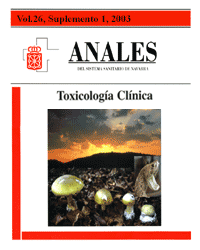Metal poisoning
Keywords:
Toxicidad. Metales. Plomo. Mercurio. Arsénico.Abstract
Metals are amongst the oldest toxic substances known to man. In today’s industrialized world the sources of exposure to metals are ubiquitous both in the field of work and from polluted water, foodstuffs and the environment. Their toxicity is characterized by the metallic element in question, but this is modified by the type of compound, whether organic or inorganic, and its characteristics of hydrosolubility and liposolubility, which determines its toxicokinetics and thus the possibilities of it reaching its targets. The biomolecules most affected by metals are the proteins with enzymatic activity, which is why their pathology is multisystemic. The principal systems affected are the gastrointestinal, central and peripheral neurological, haematic and renal. Some metallic compounds are carcinogenic. Metals’s treatment is conditioned by their chemical reactivity. They can be deactivated and eliminated by the administering of chelating agents that produce complex molecules, which are non-toxic and can be excreted. The principal chelating agents are: BAL (British Anti-Lewisite or dimercaprol) DMPS (2,3-Dimercapto-1-propanesulfonic Acid) and DMSA (meso-2,3-Dimercaptosuccinic or Succimer), EDTA, Penicilamine (b,b-dimethylcysteine) and Deferoxamine. Toxicokinetic characteristics, mechanism of action, clinical picture and treatment of some of the most relevant metals and metalloids: lead, mercury and arsenic, are considered.Downloads
Downloads
Published
How to Cite
Issue
Section
License
La revista Anales del Sistema Sanitario de Navarra es publicada por el Departamento de Salud del Gobierno de Navarra (España), quien conserva los derechos patrimoniales (copyright ) sobre el artículo publicado y favorece y permite la difusión del mismo bajo licencia Creative Commons Reconocimiento-CompartirIgual 4.0 Internacional (CC BY-SA 4.0). Esta licencia permite copiar, usar, difundir, transmitir y exponer públicamente el artículo, siempre que siempre que se cite la autoría y la publicación inicial en Anales del Sistema Sanitario de Navarra, y se distinga la existencia de esta licencia de uso.








